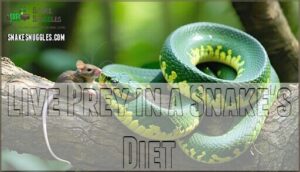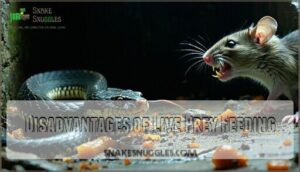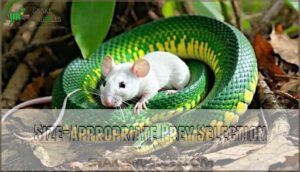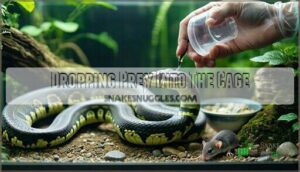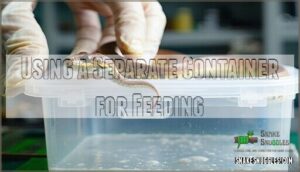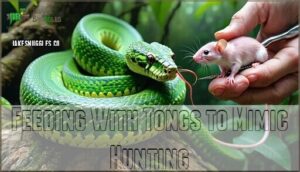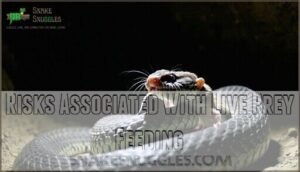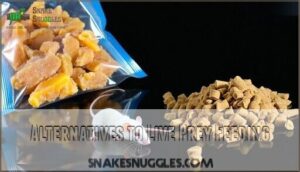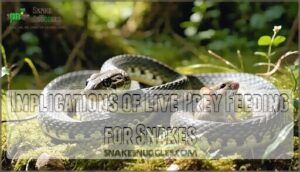This site is supported by our readers. We may earn a commission, at no cost to you, if you purchase through links.
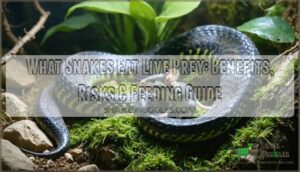
Many carnivorous snakes, like kingsnakes, pythons, and rattlesnakes, feed on live animals, ranging from insects to small mammals.
When you’re considering what snakes eat live prey, think about the benefits and risks – it can stimulate their appetite and provide essential nutrients, but also poses risks of injury and disease transmission.
As you explore the sphere of live prey feeding, you’ll discover the intricacies of providing the right diet for your pet snake, and that’s just the beginning of understanding their complex needs and how to properly care for them with live animals.
Table Of Contents
- Key Takeaways
- Live Prey in a Snake’s Diet
- Advantages of Live Prey Feeding
- Disadvantages of Live Prey Feeding
- Choosing The Right Live Prey
- Feeding Techniques for Live Prey
- Preparing for Live Prey Feeding
- Risks Associated With Live Prey Feeding
- Alternatives to Live Prey Feeding
- Encouraging Stubborn Snakes to Eat Live Prey
- Implications of Live Prey Feeding for Snakes
- Frequently Asked Questions (FAQs)
- Do any snakes eat their prey alive?
- Do any snakes eat copperheads?
- Are there any snakes you don’t have to feed mice?
- How to get a snake to eat live food?
- Can snakes eat fruit?
- What do snakes eat in captivity?
- How do venomous snakes eat?
- Do snakes eat different food?
- What types of prey do snakes eat?
- Do snakes eat insects?
- Conclusion
Key Takeaways
- You’ll find that many snakes eat live prey, including kingsnakes, pythons, and rattlesnakes, which feed on live animals ranging from insects to small mammals, and it’s essential to consider the benefits and risks of this feeding method.
- When feeding your snake live prey, it’s crucial to choose the right prey size and type, as this can affect your snake’s appetite and nutrition, and overall health, and you should research your snake’s specific needs to provide a balanced diet.
- You should be aware of the potential risks associated with live prey feeding, including injuries from defensive prey, disease transmission, and ethical concerns, and take necessary precautions to minimize these risks and ensure a safe and healthy feeding experience.
- If you’re not comfortable with live prey feeding, you can consider alternatives like frozen prey options, pre-killed prey, or commercial snake foods, which offer convenience, reduced risk, and balanced nutrition for your pet, and it’s essential to weigh the pros and cons of each option to make an informed decision.
Live Prey in a Snake’s Diet
When you’re considering live prey for your snake, you’ll find that moving food triggers natural hunting instincts and provides better nutrition than frozen alternatives.
Live prey sparks natural hunting instincts in snakes, offering superior nutrition and a more engaging mealtime experience.
Live prey offers higher nutrient density, stimulates your snake’s appetite through movement, and helps picky eaters who won’t accept pre-killed food, as it provides a more natural way of eating.
Nutrient Density and Health Benefits
Live prey delivers superior nutrient retention compared to frozen alternatives, giving your snake’s nutritional needs a significant boost.
This feeding approach enhances nutrient absorption and supports ideal digestion efficiency through fresh, unprocessed meals.
Here’s why live prey transforms your snake feeding routine:
- Enhanced hydration from fresh tissue moisture
- Immune support through active enzymes and proteins
- Dietary diversity with gut-loaded prey offering balanced nutrition
Movement Stimulation of Appetite
The moment your snake spots moving prey, something magical happens. Movement acts as a powerful appetite trigger, awakening dormant hunting instincts that millions of years of evolution have hardwired into their DNA.
Unlike frozen meals that sit motionless, live prey creates visual stimulation that activates your snake’s enhanced senses and prey recognition systems.
| Movement Benefits | Snake Response |
|---|---|
| Visual stimulation | Activates hunting mode |
| Scent trails | Triggers feeding response |
| Sound vibrations | Enhances prey detection |
This natural hunting experience taps into core natural behaviors that captive snakes rarely get to express. Snake feeding habits show that movement often makes the difference between a snake that eats readily and one that refuses meals.
The wiggling motion signals "food" in ways that motionless prey simply can’t match, creating an immediate feeding response.
Natural Hunting Experience
Beyond appetite stimulation, your snake craves the natural hunting experience that live prey provides.
This enrichment benefits their psychological well-being by activating deep-rooted hunting instincts.
Your snake’s natural behaviors emerge as they:
- Track scent trails with their forked tongue
- Calculate striking distance and timing
- Experience the satisfaction of successful prey capture
Live prey diet transforms feeding from routine into authentic snake hunting techniques.
Snakes exhibit diverse feeding habits, and prey selection varies based on species.
Importance for Picky Eaters
Some snakes turn their noses up at frozen meals like finicky toddlers rejecting vegetables.
Live prey becomes your secret weapon for these picky eaters, providing essential appetite stimulation through natural movement.
The wriggling action triggers hunting instincts and offers behavioral enrichment that frozen food can’t match.
This dietary diversity solves snake feeding challenges while delivering superior nutritional benefits for ideal snake nutrition.
Advantages of Live Prey Feeding
When you feed your snake live prey, you’re providing fresh nutrients that haven’t been lost through freezing and thawing processes.
Live prey also stimulates your snake’s natural hunting instincts, which can improve appetite and help with proper digestion, especially for picky eaters who might refuse frozen options, as it supports their proper digestion.
Increased Nutrient Absorption
When you feed your snake live prey, you’re setting up ideal nutrient bioavailability that frozen alternatives can’t match.
Fresh prey delivers peak digestion efficiency because its cellular structure remains intact, making nutrients more accessible to your snake’s gut microbiome.
The superior prey quality means better absorption of essential proteins, fats, and vitamins.
This enhanced nutrient absorption often reduces supplementation needs, giving your snake everything it requires for robust health and proper digestion naturally.
Enhanced Vitamin Absorption
Live prey delivers superior vitamin bioavailability compared to frozen alternatives.
Fresh tissue contains active enzymes that boost nutrient conversion and vitamin uptake in your snake’s system.
The intact gut microbiome of live rodents enhances digestion efficiency, while natural absorption factors remain undamaged.
This means your snake’s nutritional needs get met more effectively, maximizing health benefits from every meal.
Boosted Immune System
Feeding your snake reptile live food supercharges their immune system through natural biological processes.
Live prey delivers superior immune system benefits that frozen alternatives simply can’t match.
Here’s how snake feeding benefits work:
- Gut Microbiome Enhancement – Live prey introduces beneficial bacteria that strengthen digestive immunity
- Antibody Production Boost – Fresh nutrients trigger stronger cellular immunity responses
- Stress Reduction – Natural hunting satisfies nutritional needs while reducing captivity stress
Superior Digestive Health
Your snake’s digestive health reaches peak performance with live prey feeding.
Fresh prey delivers active enzymes and beneficial bacteria that frozen alternatives simply can’t match. Live prey also enhances vitamin absorption due to fresh, whole-food nutrition.
- Gut microbiome from live prey supports healthy digestion
- Enzyme production increases for better nutrient absorption
- Digestion efficiency improves with natural prey movement
- Waste elimination becomes more regular and complete
Disadvantages of Live Prey Feeding
While live prey offers natural benefits for your snake, you’ll face several serious challenges that make this feeding method risky and demanding.
You’re looking at potential injuries from defensive prey, disease transmission risks, expensive storage requirements, and ethical concerns that many snake owners find troubling, including potential injuries.
Risk of Injuries and Infections
Defensive prey can turn feeding time into a battlefield.
When you’re feeding live animals, rodents and other prey use prey defense mechanisms that cause bite trauma and serious snake injury.
These wounds create entry points for bacterial infections and viral transmission.
The risk of zoonotic risks means diseases can jump from prey to you during handling, making safety precautions essential for every feeding session.
Snake bites
Bacterial infections
Parasites and Disease Transmission
Beyond injuries, parasites and disease transmission pose significant threats when feeding live prey.
Almost every snake harbors internal parasites, with captive snakes facing greater parasite loads than wild ones. Zoonotic risks, bacterial infections, and viral transmission create serious health concerns.
Essential parasite prevention strategies include:
- Quarantine new prey for two weeks before feeding
- Source prey from reputable suppliers with health certifications
- Monitor snake health regularly for signs of infection
Storage and Handling Challenges
Managing live prey creates serious storage challenges you can’t ignore.
Space requirements demand dedicated areas with proper ventilation and temperature control.
Escape prevention becomes your daily battle – loose rodents spread parasites and disease transmission risks throughout your home.
Odor control requires constant cleaning, while prey maintenance means feeding schedules, fresh water, and health monitoring.
These storage challenges make frozen alternatives increasingly appealing.
Higher Cost and Ethical Concerns
Feeding live prey can hit your budget and conscience.
- Live Prey Cost: Regularly buying live prey adds up fast, especially for larger snakes.
- Animal Welfare Impact: Prey fights back, risking your snake’s safety.
- Ethical Concerns: Watching prey struggle feels unsettling, sparking debates about humane alternatives.
Responsible snakekeeping means balancing natural instincts with ethical snake feeding practices.
Choosing The Right Live Prey
You’re looking to choose the right live prey for your snake, and this is vital for species-specific diet requirements.
You’ll want to select prey that’s size-appropriate and offers a variety of nutrients to guarantee your snake’s best health and well-being.
Species-Specific Diet Requirements
You’ll often find that knowing your snake’s species is essential for determining their dietary needs.
Different snakes have unique preferences regarding prey.
For instance, corn snakes and ball pythons prefer mice or rats, while king snakes eat lizards and rodents.
Garter snakes, on the other hand, enjoy fish, amphibians, and worms.
Understanding these species-specific diet requirements is key to providing the right nutritional balance for your pet snake.
Researching your snake’s specific needs will help you make informed decisions about their diet, ensuring they receive the necessary nutrients for peak health and proper care to thrive with a balanced diet and right nutritional support.
Size-Appropriate Prey Selection
When selecting live prey, consider your snake’s age and growth stage to avoid choking hazards.
Choose prey that’s 10-15% of their weight.
Here’s your checklist:
- Understand growth stage
- Match prey to weight
- Monitor feeding habits, ensuring proper digestive capacity and nutritional needs with appropriate prey dimensions, like rodents for snakes, focusing on complete concepts and proper digestive capacity.
Prey Variety for Nutritional Balance
Once you’ve nailed the prey size, remember variety is key for a balanced diet!
Don’t let your snake diet become a nutritional rut.
You’ve got to prevent nutritional deficiencies.
Rotating prey guarantees a nutritional balance, meeting all species needs.
Think of it as a menu with mice, rats, chicks, and fish.
Each offers unique nutrients.
:
——–
:
————–
:
—————————
Don’t forget gut-loaded prey!
It’s like a bonus boost for your snake’s health!
Prey Preferences for Different Snake Species
You’re exploring snake species’ unique tastes.
- Venomous snakes prefer live birds
- Geographic variations influence prey choices
- Seasonal changes affect diets
Prey adaptations intrigue hunters, showing Dietary Adaptations and Regional Variations in snake prey, with types of snake food and prey size varying among snake species preferences.
Feeding Techniques for Live Prey
You’ll need to examine various feeding techniques when offering live prey to your snake, such as dropping prey into the cage or using tongs to mimic hunting.
By using these techniques, you can encourage your snake’s natural behavior and guarantee a successful feeding experience.
Dropping Prey Into The Cage
When introducing live prey to your snake’s cage, make certain the prey size is suitable to avoid triggering prey defense or snake aggression.
This is crucial for promoting stress reduction and owner safety during snake feeding, a key aspect of a snake’s diet and prey interaction.
Using a Separate Container for Feeding
You’ll reduce stress and hygiene concerns by feeding your snake in a separate container.
This method prevents escape, allows ease of observation, and accommodates container size.
Here are benefits:
- Prevents hand association with food
- Reduces cage constraints
- Controls feeding habits
Feeding With Tongs to Mimic Hunting
You’re now using tongs to feed your snake, simulating movement and enhancing scent.
This technique stimulates your snake’s natural hunting behavior, making feeding more engaging.
Try different tongs sizes, observing your snake’s reaction.
Small tongs can encourage a cautious approach, while medium tongs promote confidence.
This method helps create an ideal environment for feeding, releasing odors that attract your snake, and temperature stimulation that mimics its natural hunting experience.
Encouraging Natural Hunting Behavior
How can you boost your snake’s hunting game? Tongs are useful to mimic natural hunting, but don’t stop there.
Consider environmental enrichment to reduce stress and engage your snakes.
- Use different prey sizes.
- Add hiding spots.
- Introduce climbing branches.
Appropriately sized live prey challenges your snake’s hunting instincts. When opting for live prey, consider whole food prey. These feeding techniques, along with observing behavioral cues, create prey stimulation, and support natural hunting. An enriched enclosure translates into happier, healthier snakes.
Preparing for Live Prey Feeding
You’re getting ready to feed your snake live prey, and proper preparation is vital.
You’ll need to evaluate housing and storing the live prey, taking feeding and handling precautions, and following safety guidelines to guarantee a successful and safe feeding experience.
Housing and Storage of Live Prey
When housing live prey, consider a well-ventilated container with temperature control and hygiene protocols.
Choose the right prey container size to prevent escape and guarantee rodents’ comfort. You can find a suitable live prey receptacle online.
Proper storage supports stress-free snake feeding, keeping your snake care routine smooth, with a focus on live prey and snake prey needs.
Feeding and Handling Precautions
When feeding live prey, consider snake bite prevention and cage safety.
Use handling equipment and follow safe thawing procedures to minimize risks.
Consider using specialized reptile tools for safer handling.
Prioritize ethical considerations and prey sourcing for a safe and responsible snake feeding experience, ensuring your pet’s well-being and your own safety precautions.
Safety Precautions for Snake Owners
You’re handling live prey for your snake, so prioritize safety.
Consider these precautions:
- Enclosure security
- Handling techniques
- Bites and envenomation
- Hygiene protocols
- Emergency preparedness.
Make certain a secure enclosure to prevent escapes, and use tongs to minimize risks of bites and envenomation, following proper hygiene protocols to mitigate snake feeding risks and ethical concerns.
The use of tongs and proper hygiene protocols are crucial in minimizing the risks associated with handling live prey for snakes.
Risks Associated With Live Prey Feeding
You’re considering feeding your snake live prey, but it’s vital to understand the risks involved.
Feeding live prey can put you and your snake at risk of injuries, infections, and disease transmission, so it’s key to weigh the benefits against these potential dangers.
Zoonotic Parasites and Disease Transmission
You’re at risk of zoonotic parasites from live prey, which can cause illness.
Practicing good hygiene, like washing hands, is key to prevention.
Zoonotic parasites, including internal and skin parasites, can be transmitted through live prey, posing public health concerns.
Understanding parasite identification and transmission pathways is essential for zoonotic prevention, especially when handling live prey, to mitigate disease transmission and ethical concerns.
Bacterial and Viral Infections From Prey
Beyond zoonotic parasites, bacterial and viral infections from prey are concerns when you’re offering live prey.
Here’s what you should know:
- Prey pathogens can cause snake diseases.
- Infection symptoms vary, so watch closely.
- Transmission vectors include infected rodents.
- Prevention methods are key to avoiding issues.
- Treatment options, like antibiotics, exist.
These snake parasites and diseases pose real health risks. Make certain your live prey is healthy to prevent disease transmission. If your snake gets sick, antibiotics for snakes might be a solution. Stay sharp and practice prevention!
Snake Injury From Prey Defense Mechanisms
When feeding live prey, consider these precautions to prevent snake injuries:
- Watch for claws and teeth
- Use handling precautions
- Opt for prey injury prevention, minimizing prey defense wounds and infection risk, ensuring snake feeding safety and addressing ethical concerns.
Alternatives to Live Prey Feeding
You’re considering alternatives to live prey feeding for your snake, which is a great idea.
You can opt for frozen prey options, pre-killed prey, or commercial snake foods that offer convenience, reduced risk, and balanced nutrition for your pet.
Frozen Prey Options for Convenience
You can opt for frozen prey options, offering convenience and safety.
| Storage Solutions | Thawing Methods |
|---|---|
| Freezers | Cold water |
| Refrigerators | Microwave |
| Containers | Room temperature |
| Bags | Overnight thaw |
| Labels | Safety precautions |
Pre-Killed Prey for Reduced Risk
You can reduce risks with pre-killed prey, storing it frozen to maintain nutritional value.
This option offers safety benefits and considers ethical concerns, making snake feeding easier and less stressful for both you and your pet, using pre-killed rodents as a convenient alternative to live prey.
Many owners find it easier to source frozen reptile feeders online for convenience.
Commercial Snake Foods for Nutritional Balance
You can choose commercial snake foods for nutritional completeness, considering ingredient quality and brand comparisons to guarantee your snake’s diet is balanced.
Avoiding nutritional deficiencies, and storing them properly to maintain their quality.
Encouraging Stubborn Snakes to Eat Live Prey
You’re trying to encourage your stubborn snake to eat live prey, which can be challenging.
By using tongs to stimulate appetite, offering a variety of prey items, and ensuring a comfortable environment, you can increase the chances of your snake eating live prey, which involves creating an environment that encourages natural behavior, including the use of tongs.
Using Tongs to Stimulate Appetite
You’ll use the Tongs Technique to mimic hunting, stimulating your snake’s appetite.
This safe handling method reduces stress, letting you wiggle live prey and encourage feeding, making snake feeding easier and more natural, just like mimic hunting in the wild with live prey.
This helps minimize the risk of accidental bites, which is a key consideration for snake feeding and overall snake care.
Offering a Variety of Prey Items
To encourage your snake to eat, try offering a variety of prey items for dietary diversity.
- Test species
- Adjust size
- Rotate options for nutritional completeness, considering prey sourcing and gut-loading prey for ideal snake feeding.
Ensuring a Comfortable and Stress-Free Environment
You create a comfortable environment by focusing on cage enrichment, temperature regulation, and privacy importance.
This reduces stress, promoting successful snake feeding and supporting snake health.
Proper handling techniques also help, ensuring your snake feels secure when eating live prey, which is essential for its overall care and well-being.
Implications of Live Prey Feeding for Snakes
You’re about to explore the implications of live prey feeding for snakes, which involves understanding their ecological role and impact on prey populations.
As you consider feeding live prey to your snake, this is a critical point to consider, and understand how this practice affects the snake’s health and the ecosystem.
Ecological Role in Ecosystems
You’re not just feeding your snake; you’re supporting the whole food chain! Snakes play a vital ecological role, especially in pest control. Their predator-prey dynamics help maintain ecosystem balance.
Consider their ecological interactions:
- They promote healthy prey population dynamics.
- They support biodiversity impact.
- Their hunting prowess helps stabilize habitats, aiding conservation efforts.
Swamp snakes, for example, demonstrate roles in wetlands, acting as both predator and prey, which is crucial for maintaining a healthy ecosystem.
Impact on Prey Population Dynamics
As a snake owner, you impact prey population dynamics.
Snakes maintain ecosystem stability by controlling prey overpopulation, preventing cascade effects.
This ecological role has significant conservation implications, highlighting the importance of predator-prey balance and natural snake prey in maintaining ecosystem health.
Relationship With Other Predators in The Ecosystem
You’re now exploring how snakes interact with other predators in the ecosystem.
Predator competition and resource partitioning shape food web dynamics.
As a keystone species, snakes play a vital role in maintaining ecosystem stability, influencing prey population dynamics and wildlife balance.
Frequently Asked Questions (FAQs)
Do any snakes eat their prey alive?
Silky serpents surround their supper swiftly, yes, you’ll find some species eat live prey, like garter snakes consuming frogs or insects, while others prefer freshly killed meals.
Do any snakes eat copperheads?
You’ll find that king snakes, known for their fearless nature, actually eat copperheads, demonstrating a unique example of one snake preying on another venomous species in the wild.
Are there any snakes you don’t have to feed mice?
You don’t need to feed mice to garter snakes, king snakes, or certain species that eat insects, frogs, or other small animals, offering alternative feeding options.
How to get a snake to eat live food?
Carefully capture your snake’s curiosity, then use tongs to mimic live prey movement, stimulating its appetite and encouraging it to eat live food.
Can snakes eat fruit?
You can’t feed snakes fruit, as they’re strictly carnivorous, requiring high-calorie, protein-rich prey to survive, and lack the digestive system to process plant material like fruits.
What do snakes eat in captivity?
A picture is worth a thousand words," you’ll discover snakes eat pre-killed prey, like rodents, in captivity, ensuring a balanced diet and safe feeding practices for these carnivorous creatures.
How do venomous snakes eat?
You observe venomous snakes eating by striking, injecting venom, and then swallowing their prey whole, using their sharp teeth and powerful jaws to consume their meals efficiently.
Do snakes eat different food?
You’ll find that snakes eat a varied diet, including rodents, birds, fish, and insects, with each species having unique preferences and needs.
What types of prey do snakes eat?
You’ll discover snakes eat various prey, including rodents, birds, fish, insects, and amphibians, depending on species, size, and habitat.
Do snakes eat insects?
You’ll be surprised that 70% of snakes eat insects, including beetles, grasshoppers, and ants, which are small but protein-rich, making them a perfect snack.
Conclusion
Like a snake navigating its prey, you’ve traversed the domain of what snakes eat live prey, discovering its benefits and risks.
You’re now equipped to decide if live prey is right for your pet, considering the intricacies of their diet and the importance of providing the right nutrients, making informed decisions about what snakes eat live prey.
You’re now equipped to make informed decisions, and considering the intricacies of their diet is crucial for providing the right nutrients.
- https://www.nature.com/articles/s41598-019-40466-0
- https://cob.silverchair-cdn.com/cob/content_public/journal/jeb/201/21/10.1242_jeb.201.21.2913/1/2913.pdf?Expires=1645232796&Signature=kF8YMeKtyxHOqlDqR2rYlpmimPZphUQrcIXQETDYKMNKW~PWqW-wIyMR6SSsr2u0EThWE5guqynOuo~8XES-jy1L8UJy4sVDsFxtFlmaUVcFT6nJL3oCszx33viFv4kgBt7TSSPPQl6HAQbgsXL0Cq-za6KkKTJt4XHcANyOknt7y~3u9jex3BqpKs4GosnlJEJ3BJoUEO~QiU22G22qxR~i8coomJFTTsq79HKyp6qRpS9FRtQiNvV8A6zXU~7-TchrOr0q0V3LlznVQwJvowKrYbaE2~-skisklvegWbNoLboVKpfcbH0kw2ol8NW-C-xzePAJDs-87GsaLZS7iA__&Key-Pair-Id=APKAIE5G5CRDK6RD3PGA

